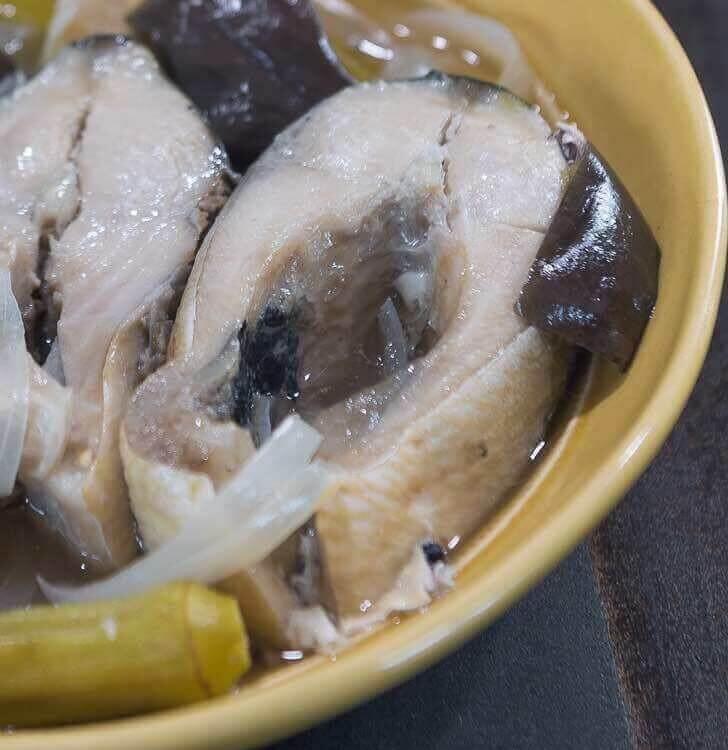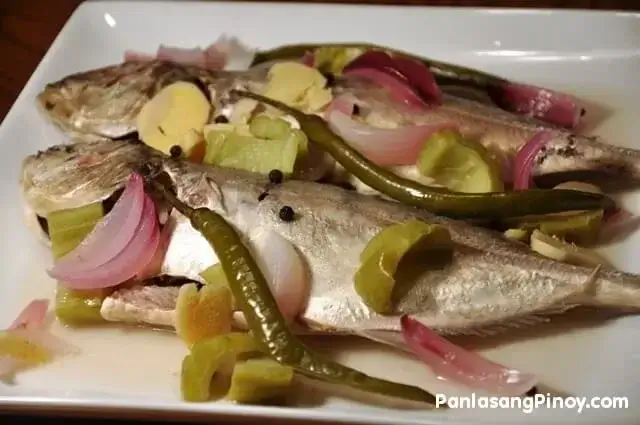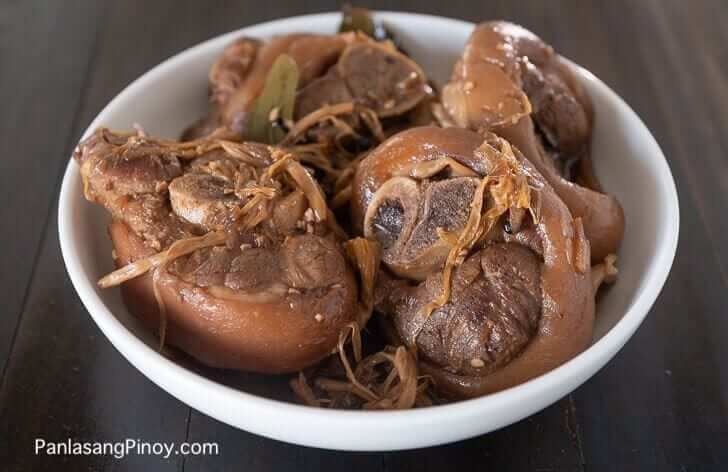Bangus Filipino Paksiw Recipe
This is probably one of my favorite Filipino paksiw recipe. It is simple, easy to make, and yummy. The part that I like most in milkfish is the belly. It is scrumptious espacially when eaten with rice.
This post may contain affiliate links. Please read our disclosure policy.
This Bangus Filipino Recipe known as Paksiw na Bangus is a classic dish that highlights the country’s love for bold and tangy flavors. It is made by stewing milkfish, or bangus, in vinegar along with garlic, ginger, onions, and a mix of spices. This bangus Filipino recipe is simple to make and requires just one pot, making it perfect for a quick but satisfying meal. The vinegar serves as the main flavoring, so it gives the dish a tangy punch that is balanced by the warmth of the garlic and ginger.

This enhanced version of Paksiw na Bangus builds on the traditional recipe by introducing more detailed instructions and additional ingredients to elevate the dish. One notable upgrade is the inclusion of bitter melons, or ampalaya. These bring an earthy and slightly bitter flavor that pairs well with the tangy vinegar base.
How to Cook Bangus Filipino Paksiw

- Rendering Pork Fat for Flavorful Oil – In a pan over medium heat, sear 3 ounces of chopped pork fat until enough oil is rendered. This step provides a flavorful base for the dish while also giving it a rich aroma. Once the oil is extracted, turn off the heat to prevent overcooking.
- Layering Aromatics – Arrange crushed garlic, thinly sliced ginger, and onions, along with 2 teaspoons of whole peppercorns, in the pot. These aromatics enhance the dish with layers of warmth and spice.
- Topping with fish slices and vegetables – On top of these, place the milkfish slices, followed by 2 sliced Chinese eggplants, 2 sliced bitter melons, and 5 long green peppers.
- Adding the Vinegar for Initial Cooking – Pour 1 ¼ cups of white vinegar evenly over the ingredients. This tangy liquid is essential for the signature sourness of the dish. Cover the pot and bring it to a boil over medium heat. Allow it to cook for 2 minutes to infuse the ingredients with the vinegar’s sharp flavor.
- Simmering for a Flavorful Broth Add 2 cups of water to balance the acidity and create a hearty broth. Let the mixture re-boil and then reduce the heat. Simmer for 15 minutes, allowing the fish and vegetables to cook through while absorbing the flavors.
- Seasoning and Serving – Season the dish with fish sauce to taste, adjusting for saltiness as needed. Once done, transfer to a serving plate and serve with steamed rice. This bangus Filipino recipe is best enjoyed fresh, and it also tastes even better as leftovers because the flavors have more time to meld and deepen!
Tips & Tricks
- Pre-Soak the Bitter Melon – To reduce the natural bitterness of ampalaya, soaking the slices in water with a pinch of salt for about 10 to 15 minutes can make a big difference. This method draws out some of the bitter compounds.
- Don’t Overcook the Fish – Milkfish is delicate and cooks quickly, so overcooking it can result in dry, less flavorful meat. Following the recommended cooking time that I shared ensures the fish remains tender, moist, and perfect for enjoying its natural flavors.

Choosing the Best Bangus for Paksiw
When selecting milkfish (bangus) for your bangus Filipino recipe, it is important to prioritize freshness and quality. Look for fish with shiny, silver scales and a firm, springy texture. These are clear signs that the bangus is fresh and ideal for cooking. If you prefer bangus with a rich, fatty flavor, look for ones with a thicker build, as these are likely to have a generous layer of belly fat. Milkfish raised in brackish water, such as the well-known Dagupan bangus from the Philippines, are especially prized for their tender meat and flavorful fat.
Other Types of Fish for Paksiw
While bangus is the traditional choice for this bangus Filipino paksiw recipe, other types of fish can work just as well. Galunggong, also known as round scad, offers an affordable yet flavorful option. Its smaller size and tender meat make it a great substitute, especially for everyday cooking. Check out my Paksiw na Galunggong Recipe if you prefer this type of fish.
For a sturdier alternative, mahi-mahi stands out due to its thick, firm texture. This type of fish holds its shape well during cooking, unlike more delicate varieties that may break apart in the tangy vinegar broth. Its rich, meaty flavor adds another layer of depth to the dish. You can try this Mahi-Mahi Paksiw Recipe of mine to make use of mahi-mahi.

Where to Find Milkfish for this Bangus Filipino Paksiw Recipe
Bangus is not exclusive to Filipino cuisine, even though it holds a central place in it. This fish is also cultivated in other Southeast Asian countries like Indonesia and Taiwan, where it plays a role in local dishes. Its farming has expanded beyond the Philippines, making it accessible in different parts of the world.
In the United States, milkfish is available in many Asian grocery stores, especially in areas with a strong Filipino or Southeast Asian presence. This global availability means you can experience the essence of Filipino cooking, no matter where you are. Enjoy this bangus Filipino recipe!
Did you make this? If you snap a photo, please be sure tag us on Instagram at @panlasangpinoy or hashtag #panlasangpinoy so we can see your creations!

Bangus Filipino Paksiw Recipe
Ingredients
- 3 1/2 lbs. milkfish cleaned and sliced crosswise into serving pieces
- 3 ounces pork fat chopped
- 5 thumbs ginger thinly sliced
- 1 head garlic crushed
- 1 ¼ cup white vinegar
- 2 cups water
- 2 onions sliced thinly
- 2 Chinese eggplants sliced
- 2 bitter melons sliced
- 5 long green pepper
- 2 teaspoons whole peppercorn
- fish sauce to taste
Instructions
- Heat a pan and sear the pork fat until enough oil gets extracted.3 ounces pork fat
- Turn off the heat. Arrange the garlic, ginger, onion, and whole peppercorns.5 thumbs ginger, 1 head garlic, 2 onions, 2 teaspoons whole peppercorn
- Top with the milkfish slices, long green peppers, eggplant, and bitter melon.3 1/2 lbs. milkfish, 2 Chinese eggplants, 5 long green pepper, 2 bitter melons
- Pour the vinegar. Turn the heat on. Cover the pot, and let it boil. Cook for 2 minutes.1 ¼ cup white vinegar
- Add water. Let the liquid re-boil. Simmer for 15 minutes.2 cups water
- Season with fish sauce.fish sauce to taste
- Transfer to a serving plate. Serve with rice.
- Share and enjoy!
Notes
Common Questions About Paksiw:
- Will the vegetables become sour when cooked with the fish in Paksiw? Vegetables like eggplant and bitter melons absorb some of the vinegar’s tangy flavor, so they do take on a slightly sour taste, but not overwhelmingly so. The level of sourness depends on how long they are simmered in the broth.
- Will the vegetables become mushy when cooked with the milkfish? In terms of texture, the vegetables should be tender but not overly soft if my recipe is followed. Eggplants may become soft but still hold their shape, while bitter melon will retain a bit of firmness even after simmering.
- Can I make Paksiw spicy? Absolutely! You can add more long green peppers or even a few slices of red chili for extra heat. Adjust the spice level to your preference.
Nutrition Information
Watch How to Cook Bangus Filipino Paksiw Recipe



Leave a Comment